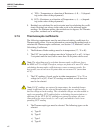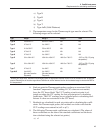
3.7 Requirements for calculating coefficients
Certain requirements apply depending on the type of coefficients being
calculated.
3.7.1 ITS-90 coefficients
The following requirements must be met when ITS-90 is selected as the type of
coefficients to calculate for Platinum probes. For more information concerning
the method used to calculate the ITS-90 coefficients, see Section 3.8, Methods
Used for Calculating Coefficients.
1. The reference probe readings must be in temperature (°C, °F or K).
2. The UUT (test probe) readings must be in resistance (Ohms or KOhms).
3. At least 2 set-points must be used, but no more than 21 set-points can be
used. The actual minimum and maximum number of set-points that can
be used depends on the selected Low Range and High Range.
4. There must be one set-point within a few degrees of the Triple Point of
Water (preferably as close to it as possible).
5. Low Range criteria:
a) The following Low Ranges can be selected
i) None
ii) ange 4 (-189.3442°C to 0.01°C)
iii) Range 5 (-38.8344°C to 29.7646°C)
b) Both Ranges 4 and 5 require the Triple Point of Water set-point and
at least 2 and no more than 10 additional set-points.
c) All set-points should fall within the temperature range of the se
-
lected Low Range.
6. High Range criteria:
a) The following High Ranges can be selected
i) None
ii) Range 6 (0.0°C to 961.78°C)
iii) Range 7 (0.0°C to 660.323°C)
iv) Range 8 (0.0°C to 419.527°C)
v) Range 9 (0.0°C to 231.928°C)
vi) Range 10 (0.0°C to 156.5985°C)
vii) Range 11 (0.0°C to 29.7646°C)
9933 TableWare
User’s Guide
38


















